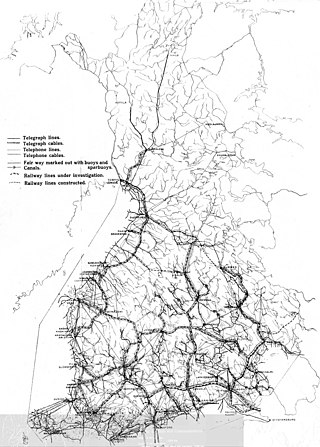
Telecommunications in Finland, as indicated by a 2022 European Commission index, highlight the country's significant role in the EU's digital sector. Finland has a high concentration of Information and Communication Technology (ICT) specialists and robust training programs, leading to notable expertise in technologies like AI and cloud computing. The nation has also made significant advancements in 5G technology. Additionally, Finland stands out for its high adoption of digital public services. The Finnish digital sector benefits from both the technology industry's contributions and government policies aimed at enhancing digital infrastructure and cybersecurity.
Telecommunications in Latvia encompass a broad range of services including the internet, telephones, television, and radio.
Telecommunications in Lithuania include internet, radio, television, and telephony.
Luxembourg is recognized for establishing local television and radio stations abroad. The RTL Group, originating from Luxembourg, operates in numerous countries. Additionally, Luxembourg is the base for Societe Europeenne des Satellites (SES), a leading global satellite operator.
Telecommunications in Poland include radio, television, fixed and mobile telephones, and the Internet.

Telecommunications infrastructure in South Africa provides modern and efficient service to urban areas, including cellular and internet services. The Independent Communications Authority of South Africa (ICASA) is the watchdog of the telecommunications in the country.

Sri Lanka Telecom PLC, doing business as SLT-MOBITEL, is the national telecommunications services provider in Sri Lanka and one of the country's largest companies with an annual turnover in excess of Rs 40 billion. The company provides domestic and corporate services which include fixed and wireless telephony, Internet access and IT services to domestic, public and business sector customers. As of 2018 SLT-MOBITEL was Sri Lanka's second largest mobile network operator with over 7.9 million subscribers.

The Internet in South Africa, one of the most technologically resourced countries on the African continent, is expanding. The internet country code top-level domain (ccTLD) .za is managed and regulated by the .za Domain Name Authority (.ZADNA) and was granted to South Africa by the Internet Corporation for Assigned Names and Numbers (ICANN) in 1990. Over 60% of Internet traffic generated on the African continent originates from South Africa. As of 2020, 41.5 million people were Internet users.
According to research done by the Organisation for Economic Co-operation and Development (OECD), the Netherlands is ranked with Switzerland in having the most broadband subscriptions per 100 inhabitants, has no bandwidth caps, and has the most homes passed in Europe in terms of connection speeds of 50 Mbit/s and higher.
Internet in Belgium has a high level of adoption and engagement, with a 93% uptake rate among individuals as of 2022, which is higher than the EU average of 89%. The country is on par with the EU average regarding digital skills, with 54% of its population having at least basic digital competencies. Belgium's commitment to digital inclusiveness is illustrated through initiatives like the BeCentral digital campus, which has trained over 425,000 students since 2017 to narrow the digital skills gap.

Internet usage in Ireland was reported at a 95% rate among individuals by 2022, higher than the European Union (EU) average of 89%. According to the European Commission's Digital Economy and Society Index (DESI) 2023 report, 70% of Irish adults had at least basic digital skills in 2021, above the EU average of 54%. Additionally, 77% demonstrated basic digital content creation skills, exceeding the EU average of 66%. Ireland's National Digital Strategy, along with the 10-year Adult Literacy for Life strategy, aims to enhance digital competencies across the workforce and society.
Internet in Malta plays a key role in enhancing the nation's digital infrastructure and public services.
The Internet in Croatia became a reality in November 1992 when the first international connection linking Zagreb and Vienna became operational.
Internet in Greece reached an 82% usage rate among individuals in 2022, yet it slightly trails behind the European Union averages in digital skills among individuals aged 16-74, as highlighted in the European Commission's Digital Decade Country Report 2023. In an effort to bridge this gap and enhance digital proficiency across the nation, Greece implemented the "Works Again" law in April 2022. This law is designed to modernize the Public Employment Service, aligning it more closely with the demands of the labor market and vocational training needs. Additionally, Greece has launched a strategic initiative for Vocational Education and Training (VET) and lifelong learning. This initiative aims to revamp educational curricula to include digital and green skills.
Internet in Portugal reached an 88% household penetration rate in 2022, with notably higher access rates in households with children. Among individuals aged 16 to 74, mobile internet use is prevalent, at 81.8%, primarily for communication and information access.
This article is about the Internet in Spain.

The term "Internet in Poland" refers to various aspects related to the state of the Internet in the Republic of Poland. This encompasses issues such as Internet access, governance, freedom, and infrastructure, as well as social, economic, and political factors that contribute to the digital landscape in Poland.
Sweden's internet usage in 2022 was 96%, higher than the European Union (EU) average of 89%. This contributes to Sweden's digital skills development, with 67% of Swedes possessing basic digital skills, compared to the EU's 54%. Additionally, 36% of Swedes have above-basic digital skills and 77% have basic digital content creation skills, exceeding the EU averages of 26% and 66%, respectively. Codeweek 2022 in Sweden also demonstrated gender inclusivity, with a female participation rate of 51%.
Internet in Estonia has one of the highest penetration rates in the world. In the first quarter of 2010, 75% out of 1.34 million people in the country used the Internet according to Statistics Estonia. In 2017, according to the World Bank came 13th in the world by the percentage of population using the Internet, with 88.1% people using it.
Telecommunications in Denmark encompasses a well-developed network of internet, telephone services, and broadcasting stations. Denmark has high internet connectivity and widespread mobile broadband adoption.



